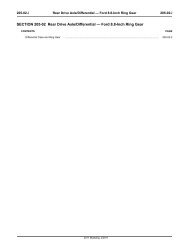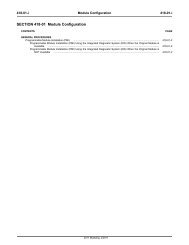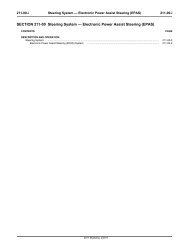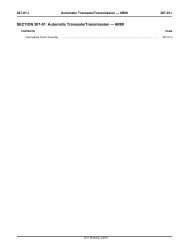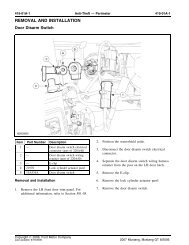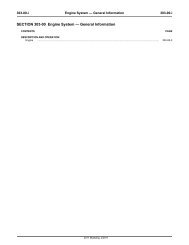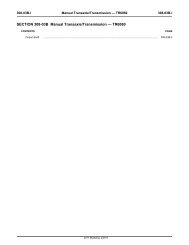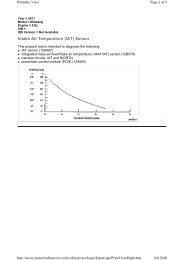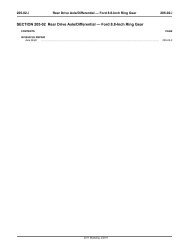Evaporative Emission (EVAP) Leak Check Monitor
Evaporative Emission (EVAP) Leak Check Monitor
Evaporative Emission (EVAP) Leak Check Monitor
Create successful ePaper yourself
Turn your PDF publications into a flip-book with our unique Google optimized e-Paper software.
Some vehicle applications with the EONV <strong>EVAP</strong> leak check monitor use a remote in-line FTP sensor.<br />
If the target pressure or vacuum on the fuel tank is achieved within the calibrated amount of time, the<br />
test is complete.<br />
4. The EONV <strong>EVAP</strong> leak check monitor uses the naturally occurring change in fuel tank pressure as a<br />
means to detect a leak in the <strong>EVAP</strong> system. At key off, a target pressure and vacuum is determined<br />
by the PCM. These target values are based on the fuel level and the ambient temperature at key off.<br />
As the fuel tank temperature increases, the pressure in the tank increases and as the temperature<br />
decreases a vacuum develops. If a leak is present in the <strong>EVAP</strong> system the fuel tank pressure or<br />
vacuum does not exceed the target value during the testing time period. The EONV <strong>EVAP</strong> leak check<br />
monitor begins at key off.<br />
After key off the normally open canister vent (CV) remains open for a calibrated amount of time to<br />
allow the fuel tank pressure to stabilize with the atmosphere. During this time period the FTP sensor<br />
is monitored for an increase in pressure. If pressure remains below a calibrated limit the CV is closed<br />
by the PCM (100% duty cycle) and seals the <strong>EVAP</strong> system from the atmosphere.<br />
If the pressure on the fuel tank decreases after the <strong>EVAP</strong> system is sealed, the EONV <strong>EVAP</strong> leak<br />
check monitor begins to monitor the fuel tank pressure. When the target vacuum is exceeded within<br />
the calibrated amount of time the test completes and the fuel tank pressure and time since key off<br />
information is stored. If the target vacuum is not reached in the calibrated amount of time, a leak is<br />
suspected and the fuel tank pressure and time since key off information is stored.<br />
If the pressure on the fuel tank increases after the <strong>EVAP</strong> system is sealed, but does not exceed the<br />
target pressure within a calibrated amount of time the CV is opened to allow the fuel tank pressure to<br />
again stabilize with the atmosphere. After a calibrated amount of time the CV is closed by the PCM<br />
and seals the <strong>EVAP</strong> system. When the fuel tank pressure exceeds either the target pressure or<br />
vacuum within the calibrated amount of time the test completes and the fuel tank pressure and time<br />
since key off information is stored. If the target pressure or vacuum is not reached in the calibrated<br />
amount of time, a leak is suspected and the fuel tank pressure and time since key off information is<br />
stored.<br />
When a leak is suspected, the PCM uses the stored fuel tank pressure and time since key off<br />
information from an average run of 4 tests to suspect a leak. Some vehicles use an alternative<br />
method of a single run of 5 tests to determine the presence of a leak. If a leak is still suspected after 2<br />
consecutive runs of 4 tests, (8 total tests) or 1 run of 5 tests, DTC P0456 is set and the MIL is<br />
illuminated.<br />
5. The EONV <strong>EVAP</strong> leak check monitor is controlled by a separate low power consuming<br />
microprocessor inside the PCM. The fuel level indicator, fuel tank pressure, and battery voltage are<br />
inputs to the microprocessor. The microprocessor outputs are the CV solenoid and the stored test<br />
information. If the separate microprocessor is unable to control the CV solenoid or communicate with<br />
other processors DTC P260F is set.<br />
6. The MIL is activated for DTCs P0456 and P260F. The MIL can also be activated for any enhanced<br />
<strong>EVAP</strong> system component DTCs in the same manner. The enhanced <strong>EVAP</strong> system component DTCs<br />
P0443, P0446, P0452, P0453, and P1451 are tested as part of the CCM.



